|
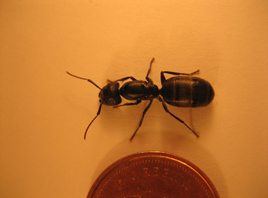 There are over a 1000 species of carpenter ants on our earth. 5 of these species are found in Quebec. These species are very well adapted to our climate, often hibernating within wood structures of homes during colder temperatures. There are over a 1000 species of carpenter ants on our earth. 5 of these species are found in Quebec. These species are very well adapted to our climate, often hibernating within wood structures of homes during colder temperatures.
You have carpenter ants in your home during spring, winter, or autumn? Then you can be assured that they have a nest within the wood structure of your home.
Carpenter ants are attracted to wood which is, or has been attained by humidity. They will dig a network of tunnels in this wood to be used as nesting grounds. Carpenter ants can seriously damage the wood structure of a home after a couple of years.
Description
Carpenter ants are in general black, but parts of their body may be slightly red or brown. These ants can measure from a ¼ inch (6mm) to ¾ inch (20mm).
During the first 2 or 3 years of a colony the queen ant (20mm) will produce worker ants (6-8mm) and soldier ants(10-12mm). After 3 years of existence the mature colony will have about 2500-3000 individuals.
At this point the queen ant will produce several winged male ants (9-10mm) and winged female ants (18-20mm).
On a hot summer day these winged ants will fly off to perform in-flight copulation. After copulation, males die and females lose their wings and become queens in search of a new nesting ground.
A queen ant may live up to 17 years and a worker or soldier ant up to 7 years.
Carpenter ants eat insects, worms, sugars, fats, mushrooms, etc.
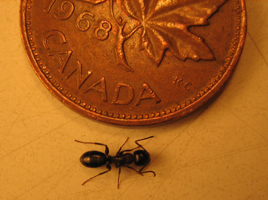 This carpenter ant is a similar but smaller version (5-7mm) of the regular carpenter ant. This carpenter ant is a similar but smaller version (5-7mm) of the regular carpenter ant.
This ant will not dig through wood to nest in, but prefers nesting in hollow structures like aluminum or pvc window or door frames or any other such hollow structures.
You have small carpenter ants in your home during spring, winter, or autumn?Then you can be assured that they have a nest within the structure of your home.
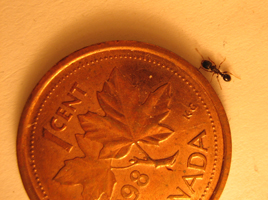 Description Description
Pavement ants vary from dark brown to black and measure 3-4 mm.Outside these ants will nest under rocks, cement slabs, in pavement cracks, in stone patios, etc.
Within homes they will nest in gaps and cracks of concrete foundations and cement floors, brick walls and chimneys and under door frames or basement window frames.
This ant can hibernate within the structure of your home during colder temperatures.
If you have these ants in your home during autumn, winter or spring, it means that a nest is living in your home.
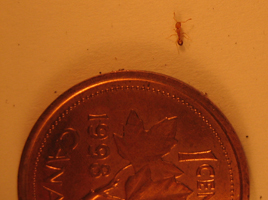 Very small, pale yellow with black marks on the abdomen; approxymately 1.5 to 3mm in length. Very small, pale yellow with black marks on the abdomen; approxymately 1.5 to 3mm in length.
The colonies can be very large, with up to several million workers and thousands of queens.
The Pharaoh ant, originally from Africa, does not hibernate, therefore it depends on artificial heat sources to survive during colder months.
Common infested areas are food stores, restaurants, hospitals, townhouses and apartment buildings.
They most often make their nests in walls or in the bottom of cardboard containers, (even sealed), that haven’t been moved for 2,3 weeks or more, such as wax paper, aluminum foil, saran wrap, cereal, hot chocolate, boxes, or even between layers of clothes, in video cassettes, computers, radios etc.
Pharaoh ants will also nest and feed outdoors during summer, entering and making nests in neighboring houses.
The most common sources of new infestations are from infected articles brought home or from an infested apartment or townhouse amongst other apartments or townhouses.
Feeding habits
Pharaoh ants will mostly feed on fats and sugars but also on other insects.
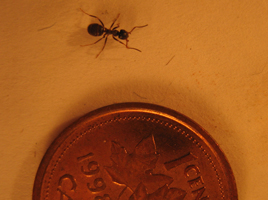 Very similar to the pavement ant, but more robuste measuring 3 to 5 mm. Very similar to the pavement ant, but more robuste measuring 3 to 5 mm.
Will nest most often outside or along building foundations but on occasion in house plants or even in walls of homes.
They are often seen in a line crawling up fruit trees or home foundations in search of food.
If you have these ants in your home during autumn, winter or spring, it means that a nest is living in your home. |

